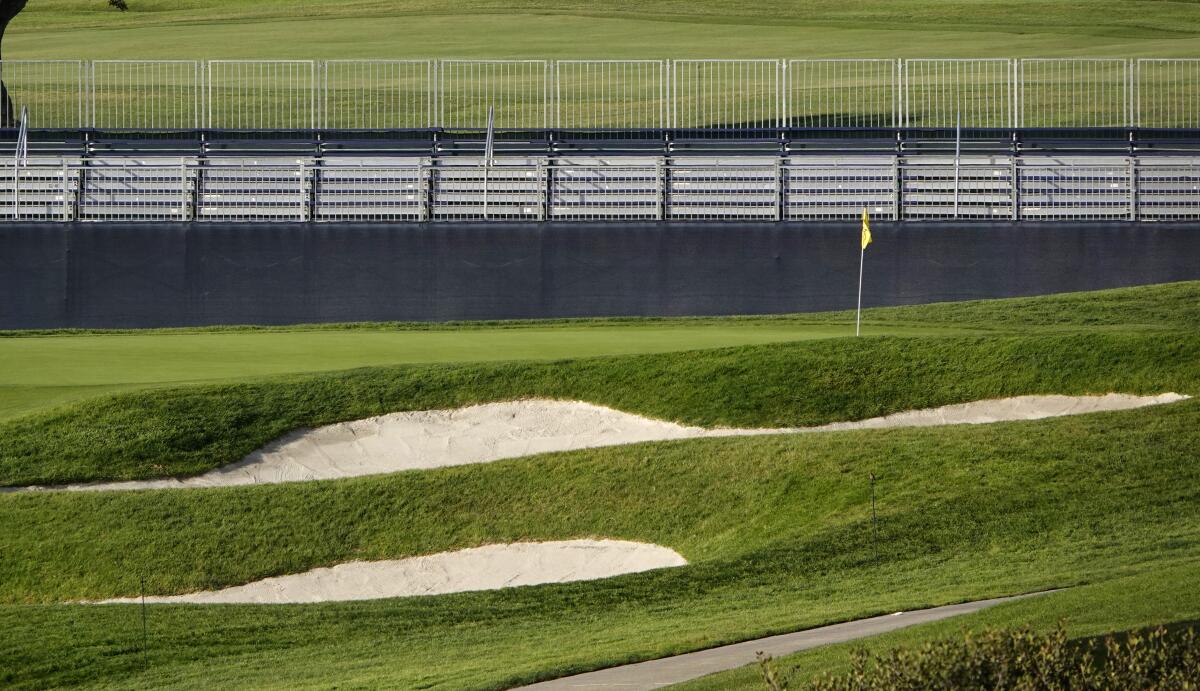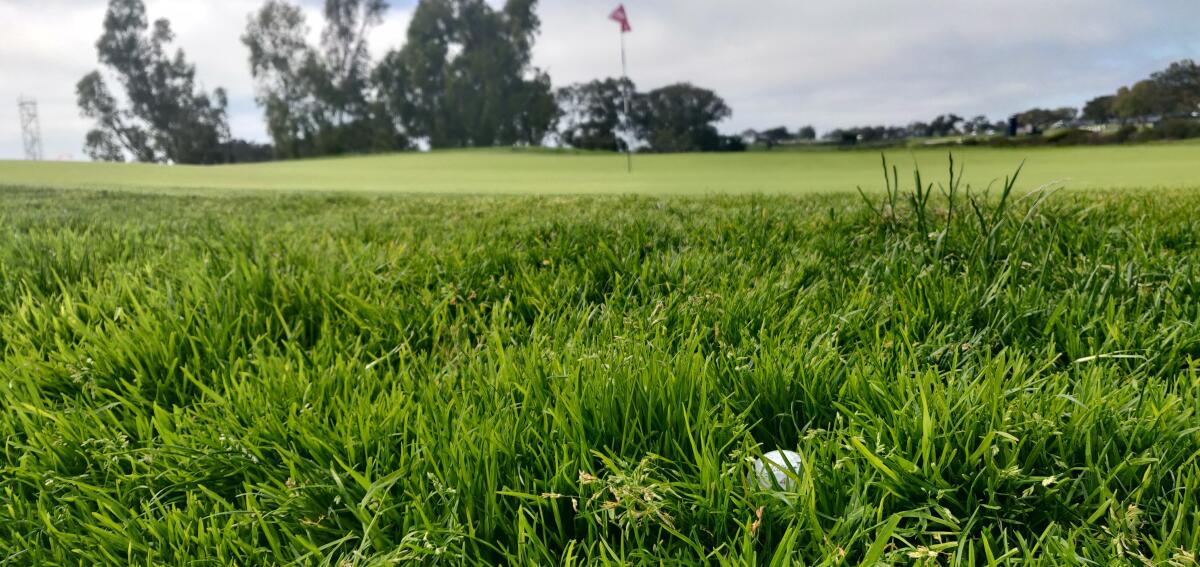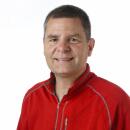Kiku-yuck: Torrey Pines’ great equalizer at U.S. Open is its diabolical rough

- Share via
The official logo for the Torrey Pines Golf Course is the namesake tree that dots the picturesque bluffs above the Pacific Ocean and grows hardly anywhere else on the planet. Its image, solitary and majestic, adorns the brick and stone sign at the entrance to the property.
A more fitting totem of the course’s unique nature, though, might be a few yards away, inside a nondescript metal pole for a handicapped parking sign. For years, a strand of kikuyu grass had grown up through it, 8 feet high.
“I’ve seen kikuyu growing in places it shouldn’t be growing,” Rich McIntosh, the city’s course superintendent for Torrey Pines. “It grows in places I don’t necessarily want it to grow. It will grow up through an orange traffic cone 2½ feet in the air, through mats we have down (on the course). As long as it’s got a lot of water and good growing conditions, it will grow anywhere. It will climb poles. It will find that sunlight.”
And there’s the poetic irony of Mother Nature. A place named for something that won’t grow anywhere else is defined by something that won’t stop growing.
Pennisetum clandestinum.
Also known as Cenchrus clandestinus.
Also known as kikuyu.
Also known as kiku-yuck.
It has its own entry in the Global Invasive Species Database: “An aggressive invader of pasture, crops and natural areas. It spreads via an external network of rhizomes and stolons, and smothers all other vegetation.”
The Torrey Pines South Course will play 7,652 yards for the U.S. Open, and to a par 71 instead of usual par 72 after the 515-yard sixth hole is fiendishly reduced from a par-5 to par-4. It has narrow fairways. It has a persistent, damp, cool, heavy wind off the ocean that suffocates approach shots. It has 54 sand bunkers with high lips interrupted by fingers of turf that can create dodgy lies. It has fast, firm, finicky greens that break toward the ocean, even if that defies the laws of physics and means they break uphill. It has deep, diabolical rough.
But what separates Torrey Pines from all other PGA Tour stops except Riviera Country Club in Los Angeles is the grass named for the Kikuyu people in the East African highlands. And even then, the kikuyu doesn’t bare its teeth during the Farmers Insurance Open in late January because it goes dormant in the winter and, in the interest of keeping the place green, the course is overseeded with more benign ryegrass.
It isn’t dormant in June.
It’s why players who came to the Farmers in January to get a preview of Torrey Pines conceded it would be a completely different golf course in June. The fairways will be the same width, the Poa annua greens roughly the same speed, the wind from the same direction (although maybe not as cold and damp), the tee boxes and pin placements in many of the same locations.
“The rough, I think, will be the big differentiator,” says John Bodenhamer, the U.S. Golf Association’s senior managing director of championships. “The biggest difference between January and June will be the kikuyu.”
In most other places, there is no kikuyu, either because it doesn’t like snow or because course superintendents treat it like a weed — like an invading foreign army — and attack it with herbicides.
Kikuyu in fairways is fine. The ball tends to sit up on its spongy surface, favoring players who pick the ball off the ground instead of those who dig the leading edge of the club into the turf. Australians and South Africans tend to play well on it, since kikuyu is prevalent on courses back home.
Kikuyu is not fine in the rough. It is thick, twisted, gnarled, sticky, grabby — not conducive to a club face travelling through it uninhibited and staying on path. It can grow to nearly 6 inches high, and about the only animate object that likes it is the long-tailed widowbird, a native of Africa that burrows into the thatch with its beak and feeds on its seeds.
“The difficult thing is, it’s mentioned in books and mentioned in classes but very briefly,” says McIntosh, the Torrey Pines superintendent who came here from kikuyu-less Ohio. “It’s a very small part of the industry. It’s seen as a weed in a lot of places, even here in Southern California. There’s not a whole lot of research out there.
“So it’s a love-hate relationship. But I think it fits perfectly here. It’s one of those things, to completely eradicate it, you’ve got to remove a lot of soil. The roots and the rhizomes are so deep in the soil out here, and it’s been out here so long, you continually fight it. You just learn to live with it.”
Which is what the 156 players in the U.S. Open will have to do this week. Live with it. Live to tell about it.
“That grass, man,” two-time U.S. Open champion Brooks Koepka says. “You put it in the rough, you’re going to struggle.”
Bodenhamer gets a glimmer in his eyes when the subject of kikuyu comes up, because, well, it’s the USGA. Its ethos is creating the “greatest test in golf,” and that often means straddling the line between manageable and masochistic. U.S. Open layouts are known for their slippery greens and deep rough, and kikuyu is the mother of all roughs.
“Our DNA is to be tough and push it to the edge, but not go over the edge,” Bodenhamer told Golf Channel recently. “We want what we create at a U.S. Open to be special, so that when these players win they’re doing something special … We have safeguards in place. But we push it hard. We want to do that, and we’ll do it again.”
In another interview, he put it this way: “We want the rough to be what it should be.”
To that end, the USGA acknowledges that the Torrey Pines rough at the 2008 U.S. Open wasn’t as infernal as they had hoped, even though Tiger Woods and Rocco Mediate were the only players under par (and that was by a single stroke). The culprit, they later realized, was the overseeded ryegrass from the Farmers, which had grown so high that the kikuyu below it never got enough sunlight through the spring to fully sprout.
So McIntosh and his crew shaved the rough down to an inch in some places, along with reducing overseed rates of the ryegrass and increasing chemical eradication “to get the kikuyu moving.” That seemed to help, although the gloomy, cloudy spring didn’t cooperate until this past week. The kikuyu is higher than in 2008, up to 6 inches or more in some area, although not uniform height and density across the course.

That presents its own challenges, however. Unpredictability is the bane of golfers.
“I think potentially it’s going to be a little deceiving,” McIntosh says. “It’s going to blend in well with the ryegrass. It’s going to allow for some inconsistent lies in the rough. The ball could sit up a couple inches, and in other areas it could sit down. You’re going to have to address every lie separately, which you don’t get with a straight ryegrass overseed.
“I think it could be a really good test, to the point where they have to think about the shot, how the ball is going to come off the club. It might make it a little more interesting than just knee-deep rough that you do everything you can just to get it out in the fairway. … As long as it’s penal, but not to the point where it’s unfair.”
Another factor: The $14 million renovation of the South Course in 2019 was largely underground, installing a modern irrigation system with 2,500 sprinkler heads that can be controlled individually by computer.
The USGA likes its U.S. Open courses “firm and fast,” which is code for they don’t water them. But if you don’t water the rough, the blades of grass lose their moisture content and lie down, making extraction easier as the tournament progresses because the ball sits up. The new sprinkler system allows them to water the rough but nothing else, keeping the kikuyu hydrated. Keeping the kikuyu as kiku-yuck.
In a practice round Sunday afternoon, reigning Masters champion Hideki Matsuyama spent 10 minutes trying to teach young Japanese pro Rikuya Hoshino the proper technique to cut through it on the backside of the 11th green, open the club face, bend the knees, explode the stroke. Hoshino swung, and the ball came out hot and skidded across the green. He dropped another ball, watched it disappear into the green forest of grass and tried again. He barely advanced it 2 feet.
The next group through included Michael Johnson, a qualifier who grinds away on mini-tours. Asked how the rough is, he laughed and said: “It’s there.”
Bryson DeChambeau, golf’s “mad scientist,” applies his cerebral, methodical approach to the thick stuff as well. During practice rounds, he’ll drop balls in it and try to hit various clubs to determine which lofts work. Also important to him his how the ball gets there, and he adjusts his shot trajectory accordingly. A low, line drive skipping along the ground has a better chance at sitting up; a high, arcing shot is more likely to be buried deep in the knotted thatch.
“It really depends on the type of grass,” DeChambeau says. “So, for example, if it’s deep down into the rough in kikuyu, it’s almost impossible to get out of. If it’s ryegrass, that’s a different situation. It could be down to the bottom, base level of the ground and you can still get it out for the most part.
“You don’t want that golf ball going to the ground in kikuyu.”
The rough was also deep last September for the U.S. Open at Winged Foot Golf Club in Mamaroneck, N.Y. DeChambeau reasoned he could get through it with his pumped-up physique and hence there was little need for driving accuracy. So he merrily blasted away with his driver into the rough, then powered wedges through it onto the greens.
Xander Schauffele, who finished fifth, said the USGA “played the tournament right into his hands” with its set-up and DeChambeau made Winged Foot “look like a pitch and putt,” winning by six strokes despite hitting only 23 of 56 fairways. It sent a collective shudder through the golf world. The last time Winged Foot was host, in 2006, in the winning score was 5-over.
“I know everyone says, ‘Look at what Bryson did last year,’” Bodenhamer says, cracking an impish smile. “We’ll see what happens this year. Kikuyu’s tough.”
More to Read
Go beyond the scoreboard
Get the latest on L.A.'s teams in the daily Sports Report newsletter.
You may occasionally receive promotional content from the Los Angeles Times.











